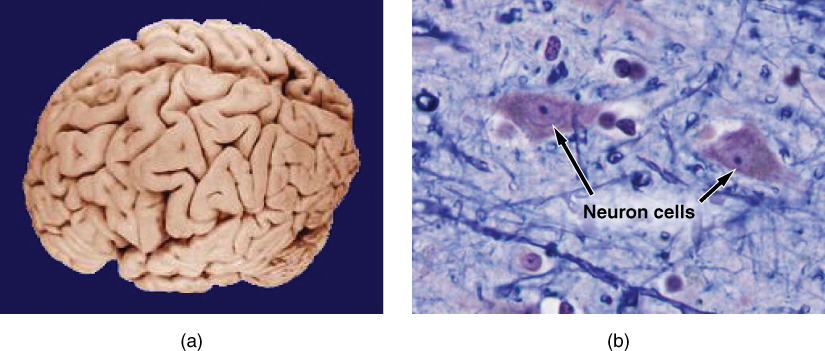1.2 Anatomy and Physiology
Anatomy and Physiology[1]
Anatomy
Human anatomy is the scientific study of the body’s structure. Some structures, such as cells, are very small and can only be observed using a microscope. Other structures, such as organs, can be easily seen and studied with the naked eye.
Like most sciences, anatomy has areas of specialization:
- Gross anatomy is the study of the large, easily visible parts of the body.
- Macro- means “large,” so gross anatomy is also referred to as macroscopic anatomy.
- Microscopic anatomy is the study of structures seen only with the use of a microscope or other magnification.
See Figure 1.1[2] for an image comparing gross anatomy and microscopic anatomy.

Anatomists are scientists who study the structure of the human body. They use two basic categories of anatomy called regional and systemic anatomy:
- Regional anatomy is the study of the structures in a specific body region, such as the abdomen. Studying regional anatomy helps us learn the relationships between body structures, such as how the muscles, nerves, blood vessels, and other structures work together in the abdomen.
- Systemic anatomy is the study of the structures that make up a specific body system – a group of structures that work together to perform a specific function. For example, a systemic study of the muscular system would look at all skeletal muscles of the body.
Physiology
Where anatomy studies the structure of the human body, physiology studies its function. Human physiology is the study of how body structures work to support life. Physiologists are scientists who study the functions of the human body. The study of physiology involves observations, manipulations, measurements, and carefully designed laboratory experiments that reveal the functions of the structures and chemicals in the human body.
Like anatomists, physiologists typically specialize in a particular branch of physiology. For example, a physiologist may study the organ level (such as exploring what different parts of the brain do) whereas another physiologist may study the molecular level (such as exploring how signals travel along nerves). Neurophysiology is the study of the brain, spinal cord, and nerves and how they work together to allow vision, movement, and thinking.
Much of the study of physiology centers on the body’s tendency towards homeostasis. Homeostasis is a steady state of internal balance that the body works to maintain. It includes monitoring and adjusting many internal conditions, such as temperature, pulse, respiratory rate, heart rate, and hormone levels. For example, the human body maintains its internal temperature at roughly 98.6° F. A temperature of 102.5° F is a disruption of that homeostasis, and the body will work to restore the temperature back to the normal temperature of 98.6° F.
- Betts, J. G., Young, K. A., Wise, J. A., Johnson, E., Poe, B., Kruse, D. H., Korol, O., Johnson, J. E., Womble, M., & DeSaix, P. (2022). Anatomy and physiology 2e. OpenStax. https://openstax.org/books/anatomy-and-physiology-2e/pages/1-introduction ↵
- “682a22ffc92a48baecc6b09fda67801df09112b4” by OpenStax is licensed under CC BY 4.0. Access for free at https://openstax.org/books/anatomy-and-physiology/pages/1-1-overview-of-anatomy-and-physiology ↵
The scientific study of the body’s structure.
The study of the large, easily visible parts of the body.
The study of structures seen only with the use of a microscope or other magnification.
The study of cells.
The study of tissues.
Scientists who study the structure of the human body.
The study of the structures in a specific body region, such as the abdomen.
The study of the structures that make up a specific body system - a group of structures that work together to perform a specific function.
The study of how body structures work to support life.
A steady state of internal balance which the body works to maintain.

